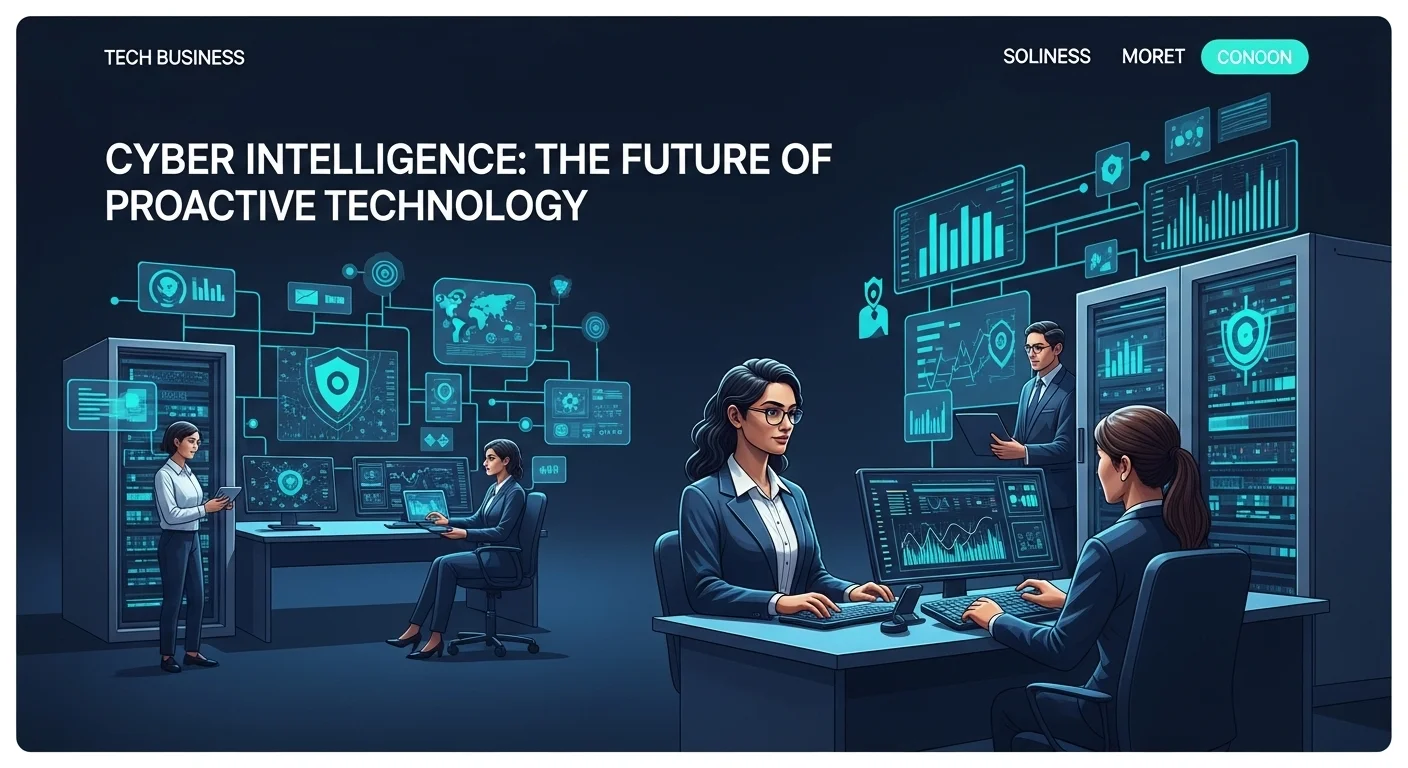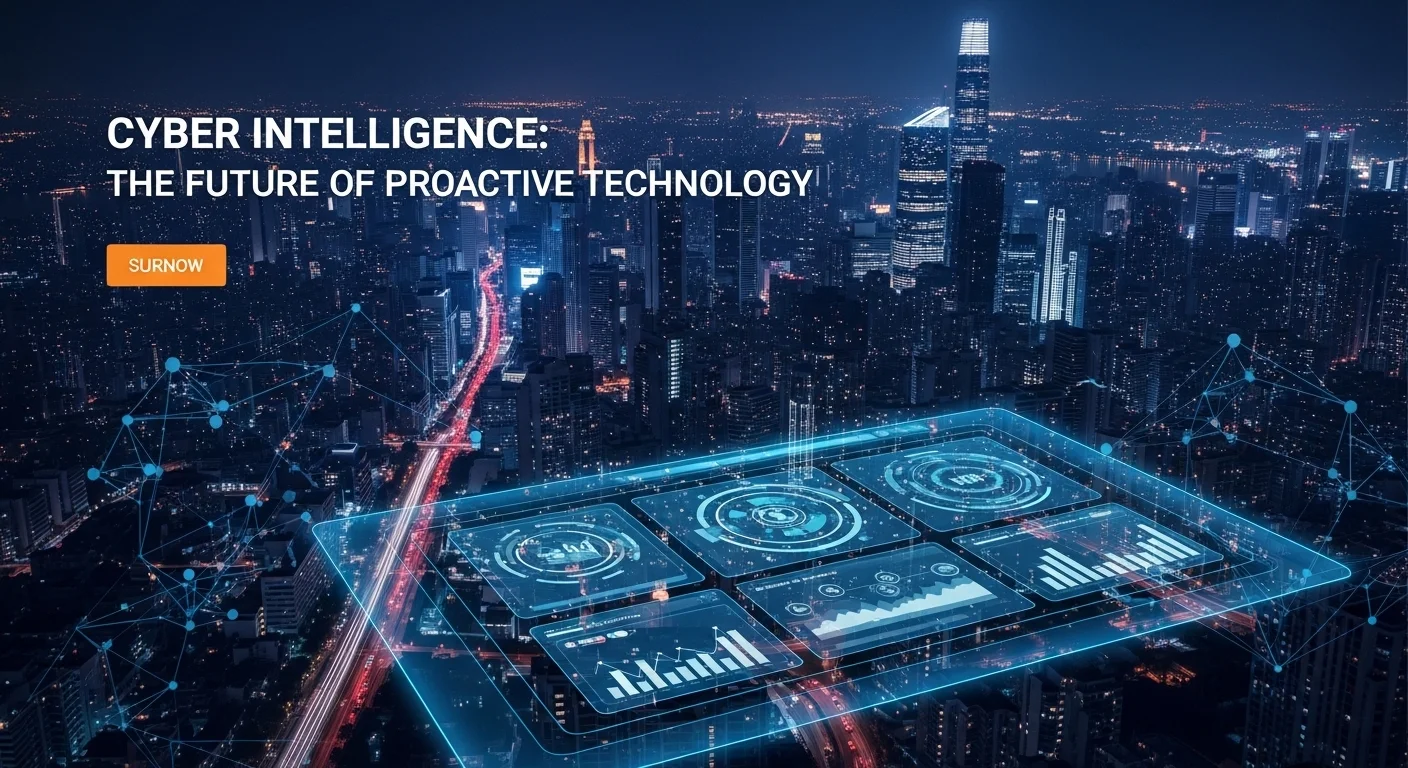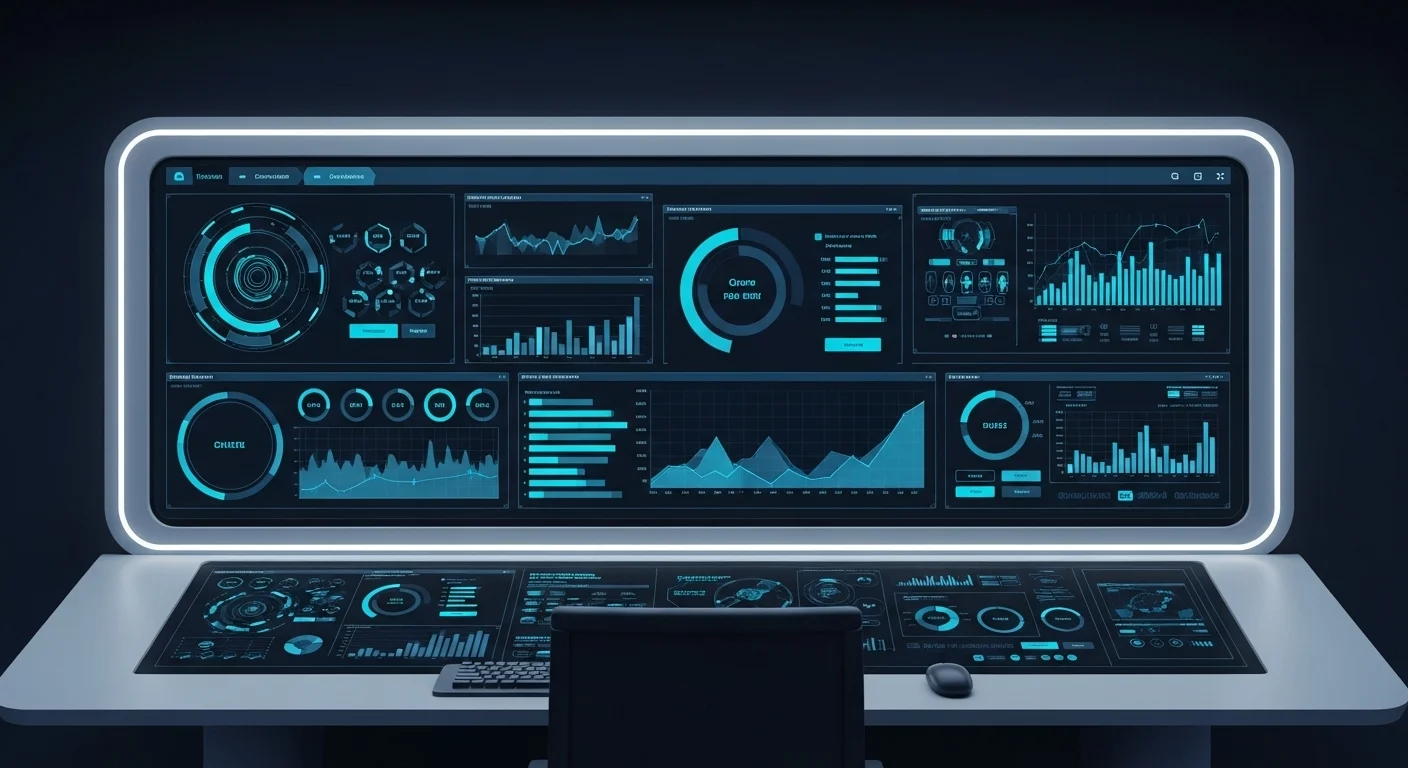Cyber Intelligence Explained: How to Stay One Step Ahead of Threats

Executive Summary
I've spent years on the front lines of cybersecurity, and if there's one thing I've learned, it's that waiting for an attack to happen is a losing game. The biggest and most important shift in our industry has been moving from just building taller walls to actively understanding who's trying to climb them, why, and how. That, in a nutshell, is Cyber Intelligence. This isn't just about collecting endless lists of malicious IPs; it's about turning threat information into a real strategic advantage. In this guide, I'll walk you through what Cyber Intelligence really is, how it works, and why it's become a non-negotiable for any business that wants to thrive online. We'll cut through the jargon and make it simple, from high-level insights for the boardroom to practical tactics for your security teams.
Table of Contents
What is Cyber Intelligence and Why Does It Matter?
In a world where nearly every part of our business lives online, the nature of risk has changed. We're no longer just defending against random, opportunistic attacks; we're up against sophisticated adversaries with specific goals. Traditional security, the kind that just reacts to alarms, simply can't keep up. This is where Cyber Intelligence, or more specifically Cyber Threat Intelligence (CTI), changes the game. Think of it as having your own reconnaissance team. Instead of just waiting for an attack, you're actively gathering and analyzing information to understand your enemy. It answers the critical questions: Who is attacking us? What do they want? How do they operate? And most importantly, what are they planning to do next? This isn't raw data; it's processed, context-rich knowledge that allows you to be proactive, to fix a vulnerability before it's exploited, and to stop an attack before it even starts. In my experience, this shift from a defensive crouch to a forward-leaning, proactive stance is the single most impactful change a security program can make.
At its heart, threat intelligence is about turning information into action. The research firm Gartner famously defines it as evidence-based knowledge about a threat that provides actionable advice. That 'actionable' part is key. To get there, we follow a process known as the intelligence lifecycle, a concept you'll see emphasized by respected institutions like the SANS Institute. This cycle is a structured way to turn noise into signal. It starts with Planning: figuring out what you actually need to know to protect your business. Then comes Collection, where you gather raw data from countless sources—public news, technical feeds, even chatter on dark web forums. After that, the data goes through Processing to get it ready for human eyes. The magic happens in the Analysis phase, where skilled analysts (or increasingly, AI) connect the dots and find the patterns. Finally, the findings are Produced into a digestible format, like a report or a briefing, and Disseminated to the people who need it, whether that's an engineer who needs to patch a server or a CEO who needs to understand the risk to a new product line. This whole process is what transforms a random piece of data into a powerful defensive weapon.
The Business Case for Cyber Intelligence
For any modern business, your digital assets—customer data, intellectual property, financial systems—are your crown jewels. And they're all potential targets. In this high-stakes environment, Cyber Intelligence isn't a cost center; it's a competitive advantage. When you understand the specific threats facing your industry, you can stop wasting money on generic security tools and focus your resources where they'll have the most impact. For example, I once worked with a financial services client who used CTI to learn about a new banking trojan. Because they knew exactly what to look for, they were able to update their defenses and train their staff on the specific phishing emails the attackers were using. They prevented a breach that could have cost them millions, not to mention the damage to their reputation. That's the real ROI of CTI—avoiding the catastrophic costs of a successful attack.
But it's not just about stopping breaches. Good intelligence supports the entire business. I'm talking about strategic cyber threat intelligence, which is tailored for the C-suite and the board. This isn't about IP addresses and file hashes; it's about the big picture. It links cyber threats to business risks, answering questions like, 'Are our plans to expand into this new region safe?' or 'What's the risk profile of that company we're thinking of acquiring?' By providing clear, business-focused answers, strategic intelligence helps leaders make smarter, more informed decisions about risk, investment, and long-term strategy. It ensures that cybersecurity isn't just an IT problem, but a core component of the business's success.
The Three Levels of Cyber Intelligence
Cyber threat intelligence isn't one-size-fits-all. To be effective, it needs to be tailored to its audience. We generally break it down into three levels. Think of it like a military operation: you have the general, the field commander, and the soldier on the ground, and each needs different information.
- Strategic Intelligence: This is the general's view. It's high-level, focused on the big picture, and looks at long-term trends and motivations. It's for your executives and board members, helping them understand the 'who' and 'why' of the threat landscape so they can steer the ship and allocate resources effectively. A strategic report might analyze the rise of ransomware gangs targeting your specific industry.
- Operational Intelligence: This is for the field commander—your security managers and incident responders. It's about the 'how' and 'where' of an attack. This intelligence details the specific tactics, techniques, and procedures (TTPs) that adversaries use in their campaigns. For instance, an operational report would describe the infrastructure a specific hacking group uses, allowing your team to hunt for it within your network.
- Tactical Intelligence: This is for the soldier on the front lines. It's the most immediate and technical form of intelligence, consisting of things like malicious IP addresses, domain names, and file hashes. We often call these Indicators of Compromise (IOCs). This information is usually fed directly into your automated security tools—firewalls, endpoint protection—to block known threats in real-time. It's essential for day-to-day defense, but these indicators have a short shelf life as attackers are constantly changing their tools.
A truly strong defense uses all three levels in harmony. The strategy guides the operation, the operation informs the hunt, and the tactical data provides the immediate blocks. Getting this right often means partnering with specialized cyber threat intelligence organizations or vendors. When my clients ask how to choose one, I often point them to analyses from firms like Gartner. A cyber threat intelligence Gartner report can be a great starting point to compare vendors and find one that provides the right mix of strategic, operational, and tactical intelligence for your needs.

A Deep Dive into CTI in Business
So, you're sold on the 'why.' The next step is the 'how.' Building a real Cyber Intelligence capability is about more than just buying a data feed. It's about weaving together the right technology, the right analytical techniques, and the right people to create a system that constantly learns and adapts. A mature program is a well-oiled machine that takes in raw data from all over, uses sharp analysis to find the hidden threats, and then pushes that critical information to every part of your security team. Let's break down how to actually build that machine.
It all starts with data sources. Your technical sources are the foundation. I'm talking about the digital breadcrumbs left behind in your own environment: logs from your network traffic, alerts from your firewalls, and data from your endpoint security tools. For example, analyzing your network logs might show a computer 'calling home' to a server known to be used by criminals. Another powerful technique is malware sandboxing—detonating a suspicious file in a safe, isolated environment to see what it does. Does it try to steal passwords? Encrypt files? This kind of hands-on analysis gives you incredibly detailed intelligence. When you combine this internal view with external data about software vulnerabilities, you can perform magic. You can see which of your systems have a specific weakness and cross-reference that with intelligence on which weaknesses are being actively exploited by attackers. Suddenly, instead of a list of 1,000 patches to apply, your IT team has a top-10 list of the ones that matter most right now. That's cyber threat intelligence in action.
Key Frameworks for Analysis
Having tons of data is useless if you can't make sense of it. Over the years, we've developed some powerful frameworks to help analysts structure their thinking and turn data into real intelligence. These aren't just academic exercises; they are tools we use every single day.
- The Cyber Kill Chain®: Developed by Lockheed Martin, this framework is brilliant in its simplicity. It lays out the seven typical steps an attacker takes, from Reconnaissance to Actions on Objective. By mapping what you're seeing to a stage in the Kill Chain, you can understand how far along an attacker is and, more importantly, where you can break the chain. If you block a phishing email, you've broken it at the 'Delivery' stage. It's a simple, linear way to visualize and disrupt an attack.
- The MITRE ATT&CK® Framework: If the Kill Chain is a simple path, ATT&CK is a comprehensive world map of everything an attacker might do *after* they get inside your network. It's a massive knowledge base of real-world tactics and techniques, like 'Credential Access' or 'Exfiltration.' In my work, we use ATT&CK constantly to model threats, test our defenses, and guide our threat hunts. Any good sans cyber threat intelligence course will drill you on using ATT&CK because it's become the common language for defenders everywhere.
- The Diamond Model of Intrusion Analysis: This model is fantastic for analysts because it helps connect the dots. It views every attack as having four key elements: an Adversary, their Infrastructure, their Capability (like a piece of malware), and the Victim. The model emphasizes the links between these four points. So if you find a new piece of malware (Capability), the model prompts you to pivot and ask: what servers does it talk to (Infrastructure)? Who uses that infrastructure (Adversary)? And who do they typically target (Victim)? It turns a single clue into a full investigation.
From a business standpoint, you need a way to manage all this. That's where a Threat Intelligence Platform (TIP) comes in. Think of it as the central nervous system for your CTI program. It pulls in data from all your sources, gives your analysts tools to work with it, and then integrates with your other security systems, like your SIEM. By feeding rich context from the TIP into your SIEM, a generic alert like 'unusual outbound connection' can be transformed into a critical incident: 'This computer is talking to a command-and-control server used by the ransomware group that hit our competitor last month.' That's how you operationalize intelligence.
Essential Resources and Standards
You don't have to go it alone. The cyber intelligence community is incredibly collaborative, and there's a rich ecosystem of organizations and vendors there to help.
Cyber Threat Intelligence Organizations: These are groups built on the idea of collective defense. Information Sharing and Analysis Centers (ISACs), for example, exist for nearly every major industry (finance, healthcare, energy, etc.). They provide a trusted space where companies can share threat data without fear. If one bank sees a new type of attack, they can anonymously warn all the other members. Government bodies like CISA in the US also provide a steady stream of public alerts and intelligence.
Commercial CTI Vendors: There's also a vibrant market of companies that do this for a living. You've probably heard names like CrowdStrike, Recorded Future, or Mandiant. These vendors have global visibility and huge research teams that can produce intelligence far beyond what most individual companies can manage. When choosing a vendor, looking at a cyber threat intelligence gartner report or a similar analysis can be a huge help. They've already done a lot of the homework, evaluating vendors on their capabilities and vision, which can save you a lot of time.
Standards and Frameworks: To make all this sharing possible, we have common languages. You'll hear acronyms like STIX and TAXII. All you need to know is that STIX is a standardized format for describing threat information, and TAXII is the protocol for sharing it. Using these standards means the intelligence feed from Vendor A can be understood by the security tool from Vendor B, making the whole ecosystem work together more smoothly.
Ultimately, a successful CTI program is a blend of art and science. It demands great technology, but it's powered by curious, skilled human analysts. It requires an understanding of both the deepest technical details and the highest-level business strategy. By pulling together the right methods, frameworks, and resources, you can build a truly resilient, intelligence-led security program ready for whatever comes next.

Actionable Tips for Your CTI Strategy
Putting a Cyber Intelligence program into practice is a marathon, not a sprint. It's a living, breathing part of your security that needs to evolve as threats and business needs change. To really get value from CTI and improve your overall security posture, you need to be strategic. Here are some of the most important tips and strategies I share with my clients, whether they're just starting out or looking to fine-tune a mature program.
The most important first step, before you spend a single dollar, is to define your goals. We call this defining 'intelligence requirements,' and it's the foundation of everything else. It's lesson number one in any sans cyber threat intelligence course for a reason. You have to ask: What do we actually need to protect? What are our biggest fears? The answers will be different for everyone. Your leadership team might need to know about threats to a new market you're entering. Your security team might need to know the specific tools being used by hackers in your industry. Without these clear questions, you'll just be collecting data for data's sake, which is a fast track to wasting time and money.
Best Practices for Implementation
Once you know your goals, follow these best practices to build a program that delivers real results:
- Seek Context, Not Just Indicators: Don't fall into the trap of measuring your program's success by the number of malicious IPs you block. A million generic indicators are less valuable than one single piece of high-quality intelligence that tells you *why* you're a target and *how* an adversary operates. Context is everything. It's the difference between knowing a door is unlocked and knowing a burglar who specializes in that type of lock is in your neighborhood.
- Fuse Inside and Outside Views: External threat feeds are great for seeing the big picture, but they become truly powerful when you combine them with your internal data. Your own network logs and incident reports are the ground truth for what's happening *in your environment*. When you see a threat from an external source that matches an event you've seen internally, you've struck gold. That's a validated, high-priority threat you need to act on immediately.
- Automate the Machine, Empower the Human: Use automation for the heavy lifting. Your Threat Intelligence Platform (TIP) and other tools should be automatically processing tactical data—ingesting feeds and blocking known bad stuff at machine speed. This frees up your human analysts to do what they do best: think critically, hunt for unknown threats, and analyze the complex 'who' and 'why' behind an attack. This is especially true for operational and strategic cyber threat intelligence, which always requires a human touch.
- Break Down the Silos: CTI isn't a one-team show. It should be a collaborative service for the entire organization. Your intelligence team needs to work hand-in-hand with your SOC, incident response, IT, and even your business leaders. Create channels for sharing information and, just as importantly, for getting feedback. This ensures the intelligence is useful and stays aligned with what the business actually needs.
Choosing the Right Tools and Resources
Picking the right tools can feel overwhelming, but it boils down to your maturity, budget, and needs.
If you're a smaller business, start with open-source intelligence (OSINT). There are fantastic free resources from places like CISA and the SANS Internet Storm Center that provide a solid baseline of tactical intelligence. As you grow, you'll likely want to invest in a commercial Threat Intelligence Platform. When you're evaluating vendors, use the criteria from a cyber threat intelligence gartner report as your shopping list. Look at their data sources, how well they integrate with your existing security tools (like your SIEM and firewalls), and the quality of their analytical tools.
Don't forget the human element. Investing in training for your team, like the SANS FOR578: Cyber Threat Intelligence course, gives them the structured thinking and skills to turn data into insight. And I can't overstate the value of community. Joining an ISAC for your industry gives you access to a trusted network of peers who are seeing the same threats you are. Often, the best and most timely cyber threat intelligence comes from a peer who gives you a heads-up.
The Future of Cyber Intelligence
For organizations with mature programs, the game becomes about optimization and proactive hunting. This is where the fun really begins.
- Intelligence-Driven Threat Hunting: Instead of waiting for an alarm, your team uses intelligence as a starting point for a hunt. For instance, 'We've learned that Adversary X is now using PowerShell in a specific way. Let's go hunt through our logs to see if anyone has tried that against us.'
- Shifting Security Left: CTI can be integrated into your software development process (DevSecOps). During the design phase, you can use threat intelligence to model how an attacker might target a new application, allowing you to build in defenses from day one.
- Proving Your Value: To keep getting budget and support, you have to show your work. Develop metrics that matter to the business. Track things like 'time to detect and respond to threats,' 'number of critical vulnerabilities patched thanks to intelligence,' or 'incidents prevented entirely.' For strategic cyber threat intelligence, show how your insights helped the business make a smarter, safer decision.
Looking forward, Artificial Intelligence is going to continue to transform this field. AI will help us sift through mountains of data faster and spot patterns no human could ever see. Many top-tier platforms are already heavily marketing their AI capabilities. The cybersecurity landscape never sits still, and neither can we. Staying curious and continuously refining your strategy is the only way to ensure your Cyber Intelligence program remains a powerful shield. As a great starting point to understand the evolving risks, the SANS Institute has a fantastic blog post on securing AI, which I highly recommend: SANS Blog on Securing AI.
Expert Reviews & Testimonials
Sarah Johnson, Business Owner ⭐⭐⭐⭐
As a small business owner, I found the breakdown of strategic vs. tactical intelligence really helpful. I wish it had a small section on low-cost tools for startups, but overall it's a great starting point.
Mike Chen, IT Consultant ⭐⭐⭐⭐
This is a solid overview of the CTI lifecycle. I appreciated the practical explanations of frameworks like ATT&CK. A good resource to share with junior analysts on my team.
Emma Davis, Tech Expert ⭐⭐⭐⭐⭐
Fantastic article! I'm studying for a security certification, and this piece connected all the dots for me in a way my textbooks haven't. The real-world examples made all the difference. Highly recommended!



